How to rotate an integer array by i times using swap function only in linear time.
- 445,704
- 82
- 492
- 529
- 5,280
- 10
- 42
- 54
-
6Please elaborate your question a bit. What dimension has the array? What do you mean by "rotating an array"? Give an example input and output. Consider using punctuation and capital letters where appropriate. – Sven Marnach Dec 16 '10 at 03:55
-
What have you tried? How does it not work? IOW, you need to try first before we help (we're not going to write it form you) – KevinDTimm Dec 16 '10 at 03:57
-
@sven suppose input array is {1,2,3,4,5} output array after one right rotation is {5,1,2,3,4}. – algo-geeks Dec 16 '10 at 03:57
-
@kevin for rotating it i times we can do it in o(n^2) times but i want o(n) complexity. – algo-geeks Dec 16 '10 at 03:58
-
don't know why someone down voted my answer, but it's possible with a easy small algorithm in O(n)! See my answer for details. – Stuck Dec 16 '10 at 04:46
-
2You should state that the operation should be done `in place` or O(1) space, otherwise, we just use another block of memory, do 3 `memmove`s. – Peter Lee Jul 16 '13 at 18:32
-
@SvenMarnach The dimension of the array is irrelevant. What is wanted here is an algorithm, or a method, or a function, but any of those will work with any value of *N*. – user207421 Mar 04 '19 at 22:48
-
Related: https://stackoverflow.com/questions/876293/fastest-algorithm-for-circle-shift-n-sized-array-for-m-position – Ciro Santilli OurBigBook.com Mar 18 '21 at 15:44
22 Answers
You can do this in linear time by using a reverse() helper.
// rotate array of size=size, by n positions
void rotate(int array[], int size, int n)
{
// reverse array[0...size-1]
reverse(array, 0, size-1);
// reverse A[0...n-1]
reverse(array, 0, n-1);
// reverse A[n...size-1]
reverse(array, n, size-1);
}
// reverse elements in the array[pos_from ... pos_to]
void reverse(int array[], int pos_from, int pos_to)
{
...
}
Implementing reverse(int array[], int pos_from, int pos_to) using swaps is left as an exercise for the reader. Hint: This can be done in linear time.
- 7,193
- 2
- 25
- 39
-
3@daydreamer You may refer to this document: http://www.cs.bell-labs.com/cm/cs/pearls/s02b.pdf If you swap the 2nd and 3rd reverse in Sanjit's code, it's more easy to understand. – Bill Xia Nov 02 '14 at 03:34
-
5The link does not work. Can you provide a link with a proof for this method? – Aryak Sengupta Mar 30 '17 at 18:30
-
1@AryakSengupta, The link can be found on the Internet Archive: https://web.archive.org/web/20080725052919/http://www.cs.bell-labs.com/cm/cs/pearls/s02b.pdf – Tenders McChiken Feb 24 '19 at 15:22
Let us say we have a function called arr_reverse(arr,i,j) which reverses the elements of the array arr between index i and j using the swap function.
Example:
arr = {1,2,3,4,5}
i = 0
j = 2
then the function will return:
{3,2,1,4,5}
^^^^^
Implementing this function is straight forward and is O(N).
Now let's use this function in rotating the array.
arr = {1,2,3,4,5} // input array
k = 2 // amount of right rotation
result = {4,5,1,2,3} // expected result
l = 5 // length of array.
Step 1: Call arr_reverse(arr,l-k,l-1) which is arr_reverse(arr,3,4)
we get {1,2,3,5,4}
^^^
Step 2: Call arr_reverse(arr,0,l-k-1) which is arr_reverse(arr,0,2)
we get {3,2,1,5,4}
^^^^^
Step 3: Call arr_reverse(arr,0,l-1) which is arr_reverse(arr,0,4)
we get {4,5,1,2,3}
^^^^^^^^^
The entire process makes use of arr_reverse 3 times, making it O(N)
- 445,704
- 82
- 492
- 529
-
I think you made a typo in Step 2 and 3 of your example, where you show the result. You have the 4 and 5 flipped from what they should be. – Nixuz Dec 16 '10 at 05:32
Here's a better solution, of a different nature than the others. It involves fewer array swaps than the others. Python:
import fractions
# rotates an array in-place i positions to the left, in linear time
def rotate(arr,i):
n = len(arr)
reps = fractions.gcd(n,i)
swaps = n / reps
for start in xrange(reps):
ix = start
tmp = arr[ix]
for s in xrange(swaps-1):
previx = ix
ix = (ix + i) % n
arr[previx] = arr[ix]
arr[ix] = tmp
return arr
- 41
- 1
Short Answer (python code)
def reverse(arr, i, j):
for idx in xrange((j - i + 1) / 2):
arr[i+idx], arr[j-idx] = arr[j-idx], arr[i+idx]
def solution(A, K):
l = len(A)
if l == 0:
return []
K = K%l
reverse(A, l - K, l -1)
reverse(A, 0, l - K -1)
reverse(A, 0, l - 1)
return A
Long Answer (code explanation)
Let me talk first the base case with K < N, the idea in this case is to split the array in two parts A and B, A is the first N-K elements array and B the last K elements. the algorithm reverse A and B separately and finally reverse the full array (with the two part reversed separately). To manage the case with K > N, think that every time you reverse the array N times you obtain the original array again so we can just use the module operator to find where to split the array (reversing only the really useful times avoiding useless shifting).
A graphical step by step example can help understanding better the concept. Note that
- The bold line indicate the the splitting point of the array (K = 3 in this example);
- The two red array indicate, respectively, the input and the expected output.
Starting from:
look that what we want in front of the final output will be the last 3 letter reversed, for now let reverse it in place (first reverse of the algorithm):
now reverse the first N-K elements (second reverse of the algorithm):
we already have the solution but in the opposite direction, we can solve it reversing the whole array (third and last reverse of the algorithm):
Here the final output, the original array cyclical rotated with K = 3.
Let give also another step by step example with python code, starting from:
A = [1, 2, 3, 4, 5, 6, 7, 8, 9, 10]
K = 22
N = len(A)
we find the splitting index:
K = K%N
#2
because, in this case, the first 20 shift will be useless, now we reverse the last K (2) elements of the original array:
reverse(A, N-K, N-1)
# [1, 2, 3, 4, 5, 6, 7, 8, 10, 9]
as you can see 9 and 10 has been shift, now we reverse the first N-K elements:
reverse(A, 0, N-K-1)
# [8, 7, 6, 5, 4, 3, 2, 1, 10, 9]
And, finally, we reverse the full array:
reverse(A, 0, N-1)
# [9, 10, 1, 2, 3, 4, 5, 6, 7, 8]
Note that reversing an array have time complexity O(N).
- 932
- 6
- 22
Using linear time O(2N+m), and constant space O(4). m = GCD(n, p)
It's up to 50% faster than the swapping approach, because swapping requires writing O(N) times to a temporary.
http://www.eis.mdx.ac.uk/staffpages/r_bornat/oldteaching/I2A/slides%209%20circshift.pdf
for (m=0, count=0; count!=n; m++) {
type t=A[m];
for (i=m, j=m+p; j!=m; i=j, j = j+p<n ? j+p : j+p-n, count++)
A[i]=A[j];
A[i]=t; count++;
}
- 9,278
- 3
- 37
- 50
public int[] shift(int[] A, int K) {
int N = A.length;
if (N == 0)
return A;
int mid = -K % N;
if (mid < 0)
mid += N;
if (mid == 0)
return A;
reverseSubArray(A, 0 , mid - 1);
reverseSubArray(A, mid , N - 1);
reverseSubArray(A, 0 , N - 1);
return A;
}
private void reverseSubArray(int[] A, int start , int end){
int i = 0;
int tmp;
while (i < (end - start + 1) / 2) {
tmp = A[i + start];
A[i + start] = A[end - i];
A[end - i] = tmp;
i++;
}
}
- 41
- 2
a naive pseudocode implementation:
for (n = 0; n < i; n++) {
for (j = array.length-1; j > n; j--)
swap(j, j-1)
}
Repeatedly moves the last element to the front, stopping before it moves anything previously moved to the front
- 27,194
- 17
- 102
- 148
This algorithm does (at most) len(array)-1 swaps, and works with both positive (right) and negative (left) rotation amounts. The array is modified in-place.
It doesn't require calculating the GCD, unlike other similar methods.
(Python 3)
def rotate(array,amount):
if amount<0:
amount+=len(array)
a=0
b=0
for _ in range(len(array)-1):
b=(b+amount) % len(array)
if b==a:
a+=1
b=a
if b!=a:
array[a],array[b] = array[b],array[a] #swap array[a],array[b]
return array

When one cycle is not enough (if it returns to the start before reaching every index), start a new cycle, from the next index.
Note: rotating items a, b, c, d, ... can be done using
swap a,b swap a,c swap a,d ...
- 992
- 10
- 22
Better use a direct and simple function, complexity N:
int rotate(int* a,int DIM,int rn,int* b) {
int i; //counter
for(i=0;i<DIM;i++){ // looping through the array
b[(i+rn)%len]=a[i]; // copying the values in the b array=a shifted with rn(+ for right or - for left shifting
}
/*
* To change this template, choose Tools | Templates
* and open the template in the editor.
*/
package rotateinlineartime;
/**
*
* @author Sunshine
*/
public class Rotator {
void reverse(int a[], int n) {
for (int i = 0; i <= n - 1; i++) {
int temp;
temp = a[i];
a[i] = a[n - 1];
a[n - 1] = temp;
n--;
}
printArray(a);
}
void printArray(int a[]) {
for (int i = 0; i < a.length; i++) {
System.out.println(a[i]);
}
}
}
/* Q: How can we shift/rotate an array in place?
A: "in place" means O(1) space complexity, so we need to do some trick
*/
#include <iostream>
#include <algorithm>
using namespace std;
void ArrayRotate(int a[], int n, int k)
{
if (n < 1 || k % n == 0 ) return;
k %= n;
if (k < 0) k += n;
reverse(a, a+k);
reverse(a+k, a+n);
reverse(a, a+n);
}
void PrintArray(int a[], int n)
{
for ( int i = 0 ; i < n; ++i)
cout << a[i] << " ";
cout << endl;
}
int main()
{
int a[] = { 1, 2 , 3, 4, 5 };
int n = sizeof(a)/sizeof (a[0]);
PrintArray(a, n);
ArrayRotate(a, n, 2);
PrintArray(a, n);
return 0;
}
/* Output:
1 2 3 4 5
3 4 5 1 2
*/
- 12,931
- 11
- 73
- 100
using only swap, following is a C++ implementation
template<class T>
void rotate_array(std::vector<T> *array, int i) {
int n = array->size();
i = i % n;
int gcd_n_i = gcd(i, n);
for (int j = 0; j < gcd_n_i; j++) {
T first_element = array->at(j);
for (int k = j; (k + i) % n != j; k = (k + i) % n) {
std::swap(array->at(k), array->at((k + i) % n));
}
}
}
You can read more about it at http://pointer-overloading.blogspot.in/2013/09/algorithms-rotating-one-dimensional.html
- 371
- 4
- 3
void reverse_array(int a[], int start, int end){
while(start < end){
int temp = a[start];
a[start] = a[end];
a[end] = temp;
start++;
end--;
}
}
void rotate_array(int a[], int pivot, int len){
int i;
/*Reverse the whole array */
reverse_array(a, 0, len);
/* Reverse from 0 to pivot and pivot to end */
reverse_array(a,0, pivot);
reverse_array(a,pivot+1,len);
}
- 11
- 3
-
This is identical to the accepted answer, which also came 3 years earlier. ;) – Sz. Nov 24 '15 at 23:59
Here's a small snippet thats works in O(n), written in JavaScript. The keyconcept is, that you always have to work with the replaced item.
function swap(arr, a, v) {
var old = arr[a];
arr[a] = v;
return old;
}
function rotate(arr, n) {
var length = arr.length;
n = n % length;
if(!n) return arr;
for(var cnt = 0,
index = 0,
value = arr[index],
startIndex = index;
cnt < length;
cnt++) {
// Calc next index
var nextIndex = mapIndex(index, n, length);
// Swap value with next
value = swap(arr, nextIndex, value)
if(nextIndex == startIndex) {
startIndex = index = mapIndex(index, 1, length);
value = arr[index];
} else {
index = nextIndex;
}
}
return arr;
}
function mapIndex(index, n, length) {
return (index - n + length) % length;
}
console.log(rotate([1,2,3,4,5,6,7,8,9], 5))
console.log(rotate([1,2,3,4,5,6], 2))
- 2,149
- 2
- 24
- 40
An O(1) method of accomplishing this, in python:
class OffsetList(list):
__slots__ = 'offset'
def __init__(self, init=[], offset=-1):
super(OffsetList, self).__init__(init)
self.offset = offset
def __getitem__(self, key):
return super(OffsetList, self).__getitem__(key + self.offset)
def __setitem__(self, key, value):
return super(OffsetList, self).__setitem__(key + self.offset, value)
def __delitem__(self, key):
return super(OffsetList, self).__delitem__(key + self.offset)
def index(self, *args):
return super(OffsetList, self).index(*args) - self.offset
This is based on this answer about using a 1-based list in python.
This does have the slight glitch that if you attempt to index an item off the end of the list, it will return items from the (new) beginning, and negative indicies less than the size minus the offset won't work.
- 1
- 1
- 4,039
- 3
- 29
- 50
here is my answer using js hope this helps where k is the number of the rotations you want to preform
var arrayRoatate=function(array,k){
for(;k>0;k--) {
var nextElementValue=undefined;
for (var i = 0; i < array.length; i=i+2) {
var nextElement = i + 1;
if (nextElement >= array.length)
nextElement = nextElement - array.length;
var tmp=array[i];
if(nextElementValue!==undefined)
array[i]=nextElementValue
nextElementValue=array[nextElement];
array[nextElement]=tmp;
}
}
return array;
- 1,681
- 1
- 14
- 12
For circular right rotation.
public static void main(String[] args) {
Scanner scan = new Scanner(System.in);
int n = scan.nextInt();
int k = scan.nextInt() % n;
int q = scan.nextInt();
int arr[] = new int[n];
for (int i = 0; i < n; i++)
{
int a = i + k;
int pos = (a < n) ? a : a - n;
arr[pos] = scan.nextInt();
}
for (int j = 0; j < q; j++)
{
System.out.println(arr[scan.nextInt()]);
}
}
- 53
- 1
- 7
-
Here we took the inputs in such a order that the input looks as if it is taken in right rotated manner. – Shubham Chaudhary Feb 04 '17 at 08:06
why only swap function?
O(n) in time and space:
var rotateCount = 1;
var arr = new Array(1,2,3,4,5,6,7,8,9,10);
tmp = new Array(arr.length);
for (var i = 0; i<arr.length; i++)
tmp[(i+rotateCount)%arr.length]=arr[i];
arr = tmp;
alert(arr);
- 11,225
- 11
- 59
- 104
-
This code doesn't work. Try rotateCount = 8, it produces: 9,10,2,3,4,5,6,7,8,1. – Nixuz Dec 16 '10 at 04:54
-
-
1Also, you really should test your code before posting it. It took me 3 seconds to test this and see that it doesn't work. – Nixuz Dec 16 '10 at 05:20
My solution with java
static int[] rotLeft(int[] a, int d) {
for (int i = 0; i < d; i++) {
oneRotation(a);
}
return a;
}
static void oneRotation(int[] a) {
int firstElement = a[0];
for (int i = 0; i < a.length - 1; i++) {
a[i] = a[i + 1];
}
a[a.length - 1] = firstElement;
}
- 35
- 4
public static String rotateKTimes(String str,int k){
int n = str.length();
//java substring has O(n) complexity
return str.substring(n-k) + str.substring(0,n-k);
}
- 11
Simple Solution in O(n) time and using O(1) space:
for e.g 1,2,3,4,5,6,7
rotating 2 times
start with index 2, store a[0] as last
Iteration 1: 1,2,1,4,3,6,5 (1-->3-->5-->7)
Iteration 2: 1,7,1,2,3,4,5 (2-->4-->6)
replace 1 with 6 (last value).
public int[] roatateArray(int[] a,int k)
{
int last = a[0];
int start = k;
for(int j=0;j<k;j++) {
for(int i=start;i<a.length;i+=k)
{
int tmp=a[i];
a[i]=last;
last=tmp;
}
start--;
if (start<=0) break;
}
a[0]=last;
return a;
}
- 31
- 1
- 4
void rotate(int array [], int n, int k)
{
int temp1,temp2; //two variable to hold values
int visited,count,index; //'visited' to check if cycle
// collides with index
//'count' to check number of loops
visited = n-1;
temp1 = array[n-1];
index = n-1;
count = 0;
while(count<n)
{
temp2 = temp1;
temp1 = array[(n+index-k)%n];
array[(n+index-k)%n] = temp2;
index = (n+index-k)%n;
if (index == visited)
{
cout<<"\nindex == visited at index = "<<index;
getch();
index--;
visited=index;
temp1=array[index];
}
count++;
cout<<"\ncount is : "<<count;
cout<<"\narray is : ";
p_all_arr(array,0,n); //display arr
getch();
}
}
- 6,144
- 2
- 34
- 42
- 11
- 2



